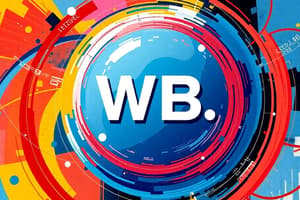Podcast
Questions and Answers
What does WWW stand for?
What does WWW stand for?
- World Web Web
- World Wide Web (correct)
- Web World Wonder
- Web Wide World
What is a web browser?
What is a web browser?
Software used to access and view the WWW.
Name three examples of web browsers.
Name three examples of web browsers.
Safari, Firefox, Chrome.
What is hypertext?
What is hypertext?
What is a hyperlink?
What is a hyperlink?
What is the difference between the Internet and the World Wide Web?
What is the difference between the Internet and the World Wide Web?
What is a search engine?
What is a search engine?
What is a website?
What is a website?
What is the homepage of a website?
What is the homepage of a website?
What are internal links?
What are internal links?
What are external links?
What are external links?
What does HTML stand for?
What does HTML stand for?
What does HTTP stand for?
What does HTTP stand for?
What is Chrome?
What is Chrome?
What does the back button do in Chrome?
What does the back button do in Chrome?
What is the function of the forward button in Chrome?
What is the function of the forward button in Chrome?
What does the reload button do?
What does the reload button do?
What is the home button in Chrome?
What is the home button in Chrome?
What is the omnibox in Chrome?
What is the omnibox in Chrome?
What are Chrome extensions?
What are Chrome extensions?
What does the apps icon in Chrome do?
What does the apps icon in Chrome do?
What does the settings icon in Chrome allow you to do?
What does the settings icon in Chrome allow you to do?
What is tabbed browsing?
What is tabbed browsing?
What are bookmarks?
What are bookmarks?
What does the history function do?
What does the history function do?
What does URL stand for?
What does URL stand for?
Identify the parts of the URL 'http://www.google.com'.
Identify the parts of the URL 'http://www.google.com'.
What is a subdomain?
What is a subdomain?
What is a domain?
What is a domain?
What is a top-level domain (TLD)?
What is a top-level domain (TLD)?
What does .com represent?
What does .com represent?
What does .gov represent?
What does .gov represent?
What does .edu represent?
What does .edu represent?
What does .org represent?
What does .org represent?
What does .net represent?
What does .net represent?
What does .mil represent?
What does .mil represent?
What does HTTPS stand for?
What does HTTPS stand for?
What are cookies?
What are cookies?
How are cookies used?
How are cookies used?
Flashcards are hidden until you start studying
Study Notes
World Wide Web (WWW)
- Stands for World Wide Web, a service of the Internet based on hypertext.
Web Browser
- Software application that enables users to access and view contents on the WWW.
Examples of Web Browsers
- Safari, Firefox, Chrome, and Internet Explorer are common web browsers available on various platforms.
Hypertext
- A method of information presentation where the reading sequence is determined by the user.
Hyperlink
- Clickable, underlined or highlighted text or images directing users to different web pages.
Internet vs. WWW
- The Internet refers to the physical connection of hardware, while the WWW is software operating on it.
Search Engine
- Programs that help locate information online; popular examples include Google, Bing, and Yahoo.
Website
- A collection of interrelated web pages grouped under a common domain.
Homepage
- The main or introductory page of a website, often termed the index page.
Internal Links
- Hyperlinks that connect different pages within the same website.
External Links
- Hyperlinks that redirect users to pages on different websites.
HTML
- Stands for Hypertext Markup Language, the primary language used for creating web pages.
HTTP
- Stands for Hypertext Transfer Protocol, essential for data communication on the WWW.
Chrome
- A web browser developed by Google, known for its speed and features.
Back Button (Chrome)
- Functionality that returns users to the previous page visited.
Forward Button (Chrome)
- Allows navigation forward to a page if previously accessed via the back button.
Reload Button (Chrome)
- Refreshes or updates the current webpage, useful for fixing loading errors.
Home Button (Chrome)
- Directs users to their designated homepage; customizable in settings.
Omnibox (Chrome)
- Combines the search and address bar, allowing entry of queries or URLs.
Chrome Extensions
- Add-ons that enhance browser functionality, examples include Google Drive.
Apps Icon (Chrome)
- Provides access to Google apps such as Docs, Slides, and Sheets.
Settings Icon (Chrome)
- Opens customization options for the Chrome browser, including search engine preferences.
Tabbed Browsing
- Feature enabling users to open multiple websites within one browser window.
Bookmarks
- User-defined lists for easy access to favorite or frequently visited websites.
History
- A record of previously viewed websites, useful for revisiting.
URL
- Stands for Uniform Resource Locator, serving as a web address.
Parts of a URL
- Consists of protocol (HTTP), subdomain (www), domain (google), and TLD (.com).
Subdomain
- A domain that is part of a primary domain, such as mail.google.com.
Domain
- A unique identifier representing an Internet authority; examples include Google and Microsoft.
Top-Level Domain (TLD)
- The most general segment in a domain name, identified by extensions like .com, .gov, and .edu.
Types of TLDs
- Commercial (e.g., .com), Government (e.g., .gov), Education (e.g., .edu), Organization (e.g., .org), Network (e.g., .net), and Military (e.g., .mil).
HTTPS
- Secure version of HTTP, ensuring encrypted communication between browser and website.
Cookies
- Small data files downloaded to a user's computer that store information about websites visited.
How Cookies Are Used
- Employed to collect, store, and share user information for enhanced browsing experiences.
Studying That Suits You
Use AI to generate personalized quizzes and flashcards to suit your learning preferences.




